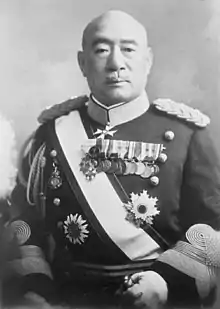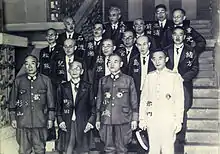Hajime Sugiyama
Hajime Sugiyama (杉山 元, Sugiyama Hajime / Sugiyama Gen, January 1, 1880 – September 12, 1945) was a Japanese field marshal and one of the leaders of Japan's military throughout most of World War II. As Army Minister in 1937, Sugiyama was a driving force behind the launch of hostilities against China in retaliation for the Marco Polo Bridge Incident. After being named the Army’s Chief of Staff in 1940, he became a leading advocate for expansion into Southeast Asia and preventive war against the United States. Upon the outbreak of hostilities in the Pacific, Sugiyama served as the army’s commander-in-chief until his removal by Prime Minister Hideki Tojo in February 1944. Following Tojo's ouster in July 1944, he was reappointed to the post of Army Minister in Kuniaki Koiso's cabinet until its dissolution in April 1945. Ten days after Japan's surrender on 2 September 1945, he committed suicide.
Hajime Sugiyama | |
|---|---|
杉山 元 | |
 | |
| 29th Army Minister | |
| In office 9 February 1937 – 3 June 1938 | |
| Monarch | Shōwa |
| Prime Minister | |
| Preceded by | Kōtarō Nakamura |
| Succeeded by | Seishirō Itagaki |
| 33rd Army Minister | |
| In office 22 July 1944 – 7 April 1945 | |
| Prime Minister | Kuniaki Koiso |
| Preceded by | Hideki Tojo |
| Succeeded by | Korechika Anami |
| Chief of the Imperial Japanese Army General Staff | |
| In office 3 October 1940 – 21 February 1944 | |
| Monarch | Shōwa |
| Prime Minister | |
| Preceded by | Prince Kan'in Kotohito |
| Succeeded by | Hideki Tojo |
| Personal details | |
| Born | January 1, 1880 Kokura, Fukuoka Prefecture |
| Died | September 12, 1945 (aged 65) Tokyo, Japan |
| Awards | Order of the Golden Kite, Order of the Rising Sun |
| Military service | |
| Allegiance | |
| Branch/service | |
| Years of service | 1901–1945 |
| Rank | |
| Commands | 12th Division Northern China Area Army First General Army |
| Battles/wars | Russo-Japanese War Second Sino-Japanese War World War II |
Biography
Early career
Born to a former samurai family from Kokura (now part of Kitakyushu City), Fukuoka Prefecture, Sugiyama graduated from the 12th class of the Imperial Japanese Army Academy in 1901. He served as a junior officer with 3rd Battalion of the 14th Regiment of the IJA 12th Division in the Russo-Japanese War,[1] and was wounded in the face during the Battle of Shaho. Due to scars from that injury, he was unable to fully open his right eye.
After graduating from the 22nd class of the Army Staff College in 1910, Sugiyama served in Section 2 (Intelligence) within the Imperial Japanese Army General Staff. He was posted as military attaché to the Philippines and Singapore in 1912, disguised as a civilian trading company employee, and disguised as a Imperial Japanese Navy lieutenant, joined in an inspection tour of the United States Navy base at Subic Bay. Promoted to major in 1913, he was posted again as military attaché to British India in 1915, where he met in secret with Indian independence activists Rash Behari Bose and Subhas Chandra Bose. In 1918, he was sent as a military observer to the Middle Eastern theatre of World War I. At the end of the war, he served on the League of Nations committee on military aviation.
On his return to Japan, Sugiyama was promoted to lieutenant colonel, and commander of the 2nd Air Battalion in December 1918. He was a strong proponent of military aviation, and after his promotion to colonel in 1921, became the first head of the Imperial Japanese Army Air Service in 1922. From 1924, he became a protege of Army Minister Ugaki Kazushige. In May 1925, Sugiyama became a major general and Director of the Bureau of Military Affair in 1928. He was also a participant in the March incident of 1931, a failed coup-d'etat which attempted to make Ugaki Prime Minister. Later that year, as Under Secretary of the Army he made an official announcement defending the actions of the army in the Mukden Incident.
With the rise of the radical Kōdōha faction under Sadao Araki to the post of Army Minister, Sugiyama was sidelined to the Imperial Japanese Army Air Service in March 1933. However, the failed coup d'etat of the February 26 incident in 1936 led to a purge of the Kōdōha from positions of authority and Sugiyama was promoted to full general in November 1936.[2]
Second Sino-Japanese War

In February 1937, Sugiyama became Army Minister in the cabinet of Prime Minister Senjūrō Hayashi and remained in that position under the succeeding Prime Minister, Fumimaro Konoe. During his tenure, tensions between Japanese forces and the Chinese grew more severe, before hostilities broke out between the two near the Marco Polo Bridge. Subsequently, Sugiyama pushed Konoe for retaliation against China, thereby giving rise to the Second Sino-Japanese War. In December 1938, he briefly accepted a field command as commanding general of North China Area Army and the Mongolia Garrison Army in December 1938.
World War II


On September 3, 1940, he succeeded elderly Prince Kan'in Kotohito as Chief of the Imperial Japanese Army General Staff. He was one of the leading Army officers lobbying for war with the West. However, on September 5, 1941, on the verge of the war against the United States and Great Britain, he was severely berated by Emperor Hirohito for having earlier predicted in 1937 that Japanese invasion of China would be completed within three months, and challenged over his confidence in a quick victory over the Western powers.[3]
Sugiyama was awarded the honorary rank of field marshal in 1943. As the war fronts collapsed on all sides, Sugiyama was relieved of his post as Chief of the General Staff on February 21, 1944, by General Hideki Tōjō (who continued to serve concurrently as Prime Minister).
Sugiyama was appointed to the Inspector-general of Military Training, which was still one of the most prestigious positions in the Army. After Tōjō's ouster in 1944, Sugiyama again became Army Minister. In July 1945, he was asked to take command of the First General Army, which directed defenses of eastern half Japanese mainland against the anticipated Allied invasion.[4]
Ten days after the surrender of Japan, after finishing preparations for the final dissolution of the Imperial Japanese Army as dictated by the victorious Allied Powers, Sugiyama committed suicide by shooting himself four times in the chest with his revolver while seated at his desk in his office. At home, his wife also killed herself.[5] His grave is at the Tama Cemetery, in Fuchū, Tokyo.
References
- Budge, The Pacific War Online Encyclopedia
- Ammenthorp, The Generals of World War II
- Bix, Hirohito and the Making of Modern Japan
- Frank, Downfall The End of the Japanese Empire
- Chen, WW2 Database
Books
- Bix, Herbert P. (2001). Hirohito and the Making of Modern Japan . New York: Harper Perennial. ISBN 0-06-093130-2.
- Dupuy, Trevor N. (1992). Harper Encyclopedia of Military Biography. New York: HarperCollins Publishers Inc. ISBN 0-7858-0437-4.
- Frank, Richard B. (1999). Downfall: the End of the Imperial Japanese Empire. Penguin, non-classics. ISBN 0-14-100146-1.
- Fuller, Richard (1992). Shokan: Hirohito's Samurai. London: Arms and Armor. ISBN 1-85409-151-4.
- Hayashi, Saburo; Cox, Alvin D (1959). Kogun: The Japanese Army in the Pacific War. Quantico, Virginia: The Marine Corps Association.
External links
| Wikimedia Commons has media related to Hajime Sugiyama. |
- Ammenthorp, Steen. "Sugiyama Hajime". The Generals of World War II.
- Budge, Kent. "Sugiyama Gen". Pacific War Online Encyclopedia.
- Chen, Peter. "Sugiyama Hajima". WW2 Database.
| Political offices | ||
|---|---|---|
| Preceded by Kōtarō Nakamura |
Army Minister Feb 1937 – June 1938 |
Succeeded by Seishirō Itagaki |
| Preceded by Tōjō Hideki |
Army Minister Jul 1944 – Apr 1945 |
Succeeded by Anami Korechika |
| Military offices | ||
| Preceded by none |
Commander IJA 1st General Army Apr 1945 – Sept 1945 |
Succeeded by Kenji Doihara |
| Preceded by Otozō Yamada |
Inspector-General of Military Training Jul 1944 – Nov 1944 |
Succeeded by Shunroku Hata |
| Preceded by Prince Kan'in Kotohito |
Chief of Imperial Japanese Army General Staff Oct 1940 – Feb 1944 |
Succeeded by Tōjō Hideki |
| Preceded by Shigeru Hasunuma |
Commander Mongolia Garrison Army Aug 1939 – Sept 1939 |
Succeeded by Naozaburo Okabe |
| Preceded by Hisaichi Terauchi |
Commander North China Area Army Dec 1938 – Aug 1939 |
Succeeded by Hayao Tada |
| Preceded by Yoshikazu Nishi |
Inspector-General of Military Training Aug 1936 – Feb 1937 |
Succeeded by Hisaichi Terauchi |